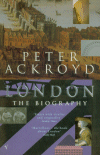| 'London - The
Biography' by Peter Ackroyd |
 |
| 'London - The
Biography' by Peter Ackroyd |
 |
A few years ago I reviewed Stephen Inwood's magnificent book, 'A History of London'. At the time I had little expectation that I would see another book about London that was its equal. Well I was wrong! Peter Ackroyd's book is just as good as Inwood's, and treats its subject from a different, and to my mind, complementary angle. Ackroyd looks at London as a living entity and the results are fascinating, even if they do descend occasionally into an irritating mysticism. Apart from the first few sections dealing with the early history of London, the book treats its account of the city thematically rather than chronologically. It is this thematic treatment that drives the book's raison d'etre - continuity. What Ackroyd is fascinated by, and passes on to the reader, is the dialectic of continuity, renewal and decay, but especially continuity. London is a city constantly renewing itself - both its commerce and its physical fabric. Very little of the pre-Victorian city appears to have survived its nineteen century rebuilding as the capital city of the British Empire, but there are surprising continuities in the lines of the streets and the nature of the different areas that now compose greater London. Take for instance, as Ackroyd does, the case of Clerkenwell. Clerkenwell is a small nondescript looking area based around Clerkenwell Green. There are dozens of similar looking areas scattered around London, but Clerkenwell is different. For over 700 years, and through innumerable changes in its physical environs it has been a centre of heretical, reforming and radical activity. As long ago as 1301 there were complaints about disorder of local inhabitants. Eighty years later Wat Tyler's followers torched the local priory and beheaded the prior. From 1414 it harboured in succession Lollards, Catholics, Quakers and Freemasons. John Wilkes was born there in 1727, and later in that century the Bull's Head in Clerkenwell was one of the first meeting places of the egalitarian London Corresponding Society. In the nineteenth century it was the site of major rallies by the Chartists and the National Union of the Working Classes - a policeman was killed in an affray during the latter rally. Later in the century Eleanor Marx Aveling, and the Russian anarchist Kropotkin used it as a centre for demonstrations and mass meetings. Still later - at the start of the twentieth century Lenin edited the revolutionary magazine 'Iskra' from an office overlooking the Green, and until its demise at the end of the cold war the Communist newspaper the 'Morning Star' had is offices in Farringdon Road, hard by the Green. Even today 'The Big Issue', the radical magazine for the homeless and unemployed has its home in the same area where Wat Tyler and his followers camped over six hundred years earlier. This is only one example of the continuities in London. Ackroyd's book traces many others with an eye for sharp detail and a rare ability draw out finely detailed vignettes while not losing sight of the broader picture. Sewers, churches, the mob, buried rivers, mystics, murderers, the poor, the blitz, the fogs and, of course, Old Father Thames. All these and much, much, more are part of the tapestry of London life woven by Ackroyd in this account. Buy it, read it from cover to cover, or just dip into different sections, you will find it well worth your while. Highly recommended.
'London The Biography' by Peter Ackroyd |
If you have any questions or comments about the articles on my web site, click here to send me email. |